This pub is named after its previous use as a bank. The building was designed and built in 1904 for the York & County. It became the Midland Bank in 1918, which it remained until it relocated in 1989.
Framed photographs and text about The Bankers Draft.
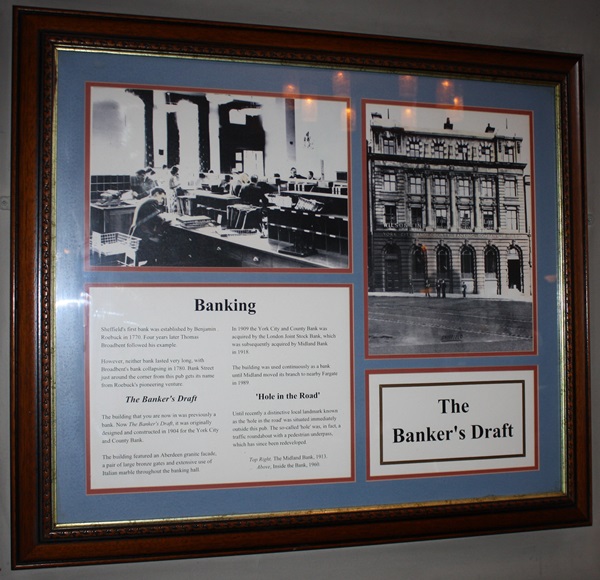
The text reads: Sheffield’s first bank was established by Benjamin Roebuck in 1770. Four years later Thomas Broadbent followed his example.
However, neither bank lasted very long, with Broadbent’s bank collapsing in 1780. Bank Street just around the corner from this pub gets its name from Roebuck’s pioneering venture.
The building that you are now in was previously a bank. Now The Banker’s Draft, it was originally designed and constructed in 1904 for the York City and County Bank.
The building featured an Aberdeen granite façade, a pair of large bronze gates and extensive use of Italian marble throughout the banking hall.
In 1909 the York City and County Bank was acquired by the London Joint Stock Bank, which was subsequently acquired by Midland Bank in 1918.
The building was used continuously as a bank until Midland moved its branch to nearby Fargate in 1989.
Until recently a distinctive local landmark known as the ‘hole in the road’ was situated immediately outside this pub. The so-called ‘hole’ was, in fact, a traffic roundabout with a pedestrian underpass, which has since been redeveloped.
Top right: The Midland Bank, 1913.
Above: Inside the Bank, 1960.
Inside the old stables – found on the lower ground floor.
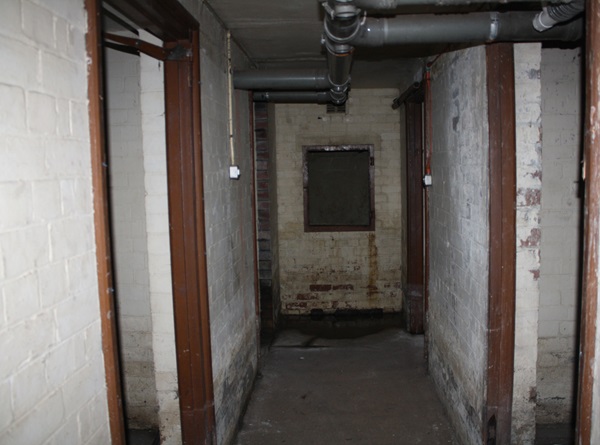
These stables were used when people were visiting Sheffield… and the bank. They would sometimes leave their horses overnight.
Inside one of the old stables.
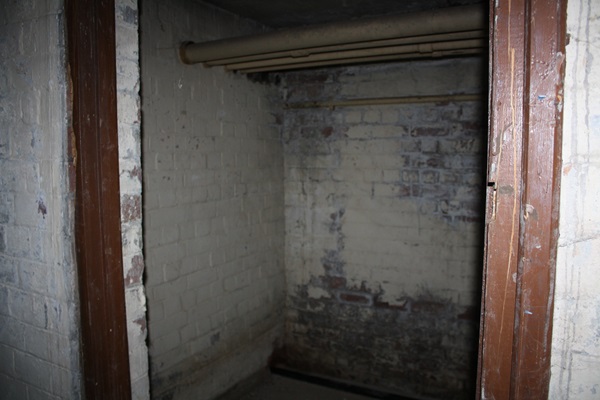
The entrance to an old lift on the lower-ground floor – used to move through the bank.
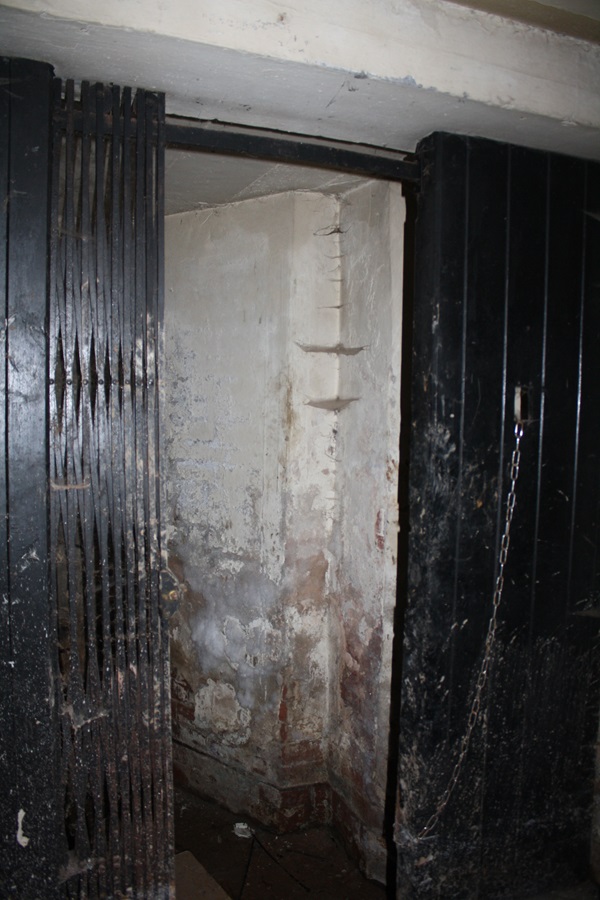
The entrance to an old lift on the upper-ground floor.
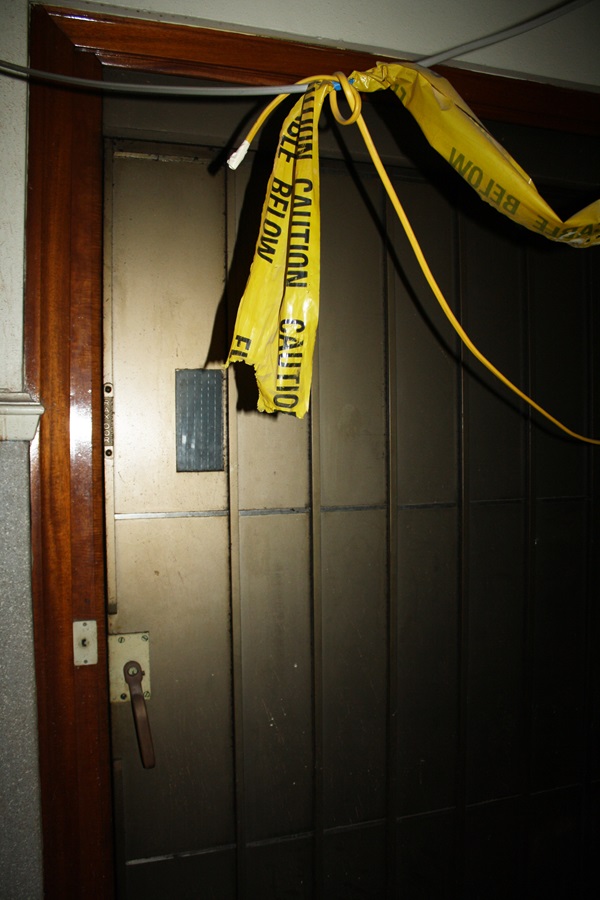
An old steel door, used for high security during the days of the building as a bank.
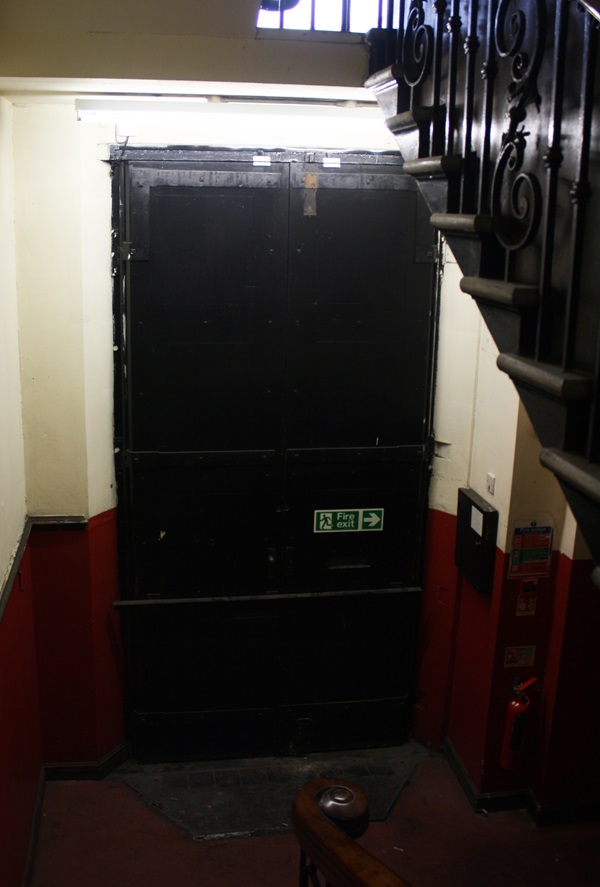
The original railings on the stairs (now out of bounds) and those in the pub have been replaced.
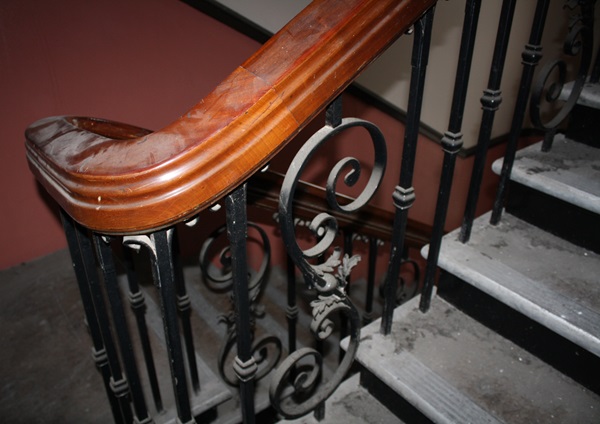
A hallway on one of the top floors, leading to the old offices for the bank.
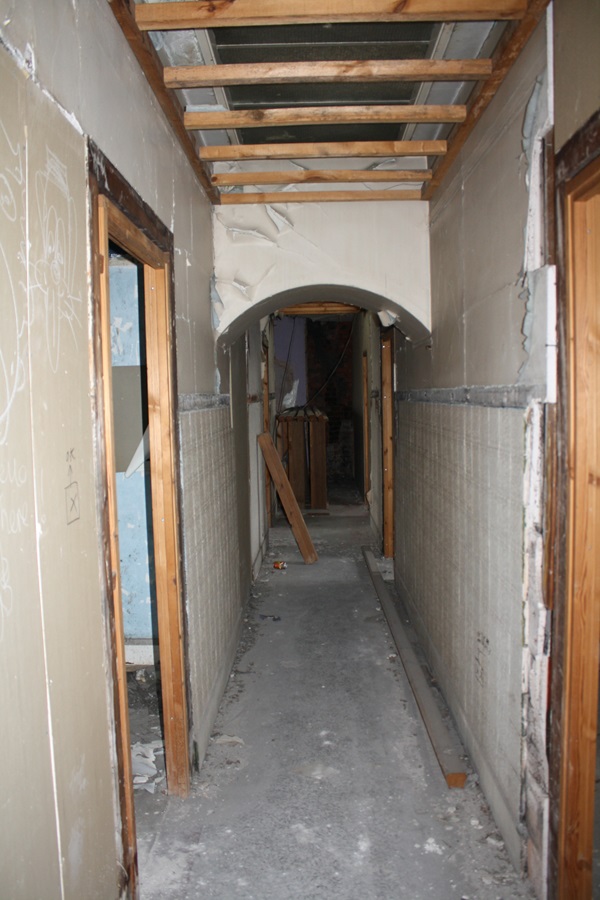
Framed photographs and text about Sir John Fowler.
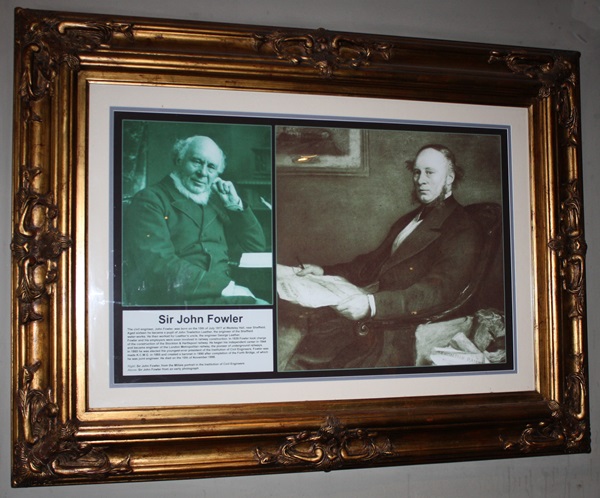
The text reads: The civil engineer, John Fowler, was born on the 15th July 1817 at Wadsley Hall, near Sheffield. Aged sixteen he became a pupil of John Towlerton Leather, the engineer of the Sheffield water-works. He then worked for Leather’s uncle, the engineer George Leather.
Fowler and his employers were soon involved in railway construction. In 1839 Fowler took charge of the construction of the Stockton and Hartlepool railway. He began his independent career in 1844 and became engineer of the London Metropolitan railway, the pioneer of underground railways. In 1865he was elected the youngest-ever presiendt of the Institution of Civil Engineers. Fowler was made K.C.M.G in 1885 and created a baronet in 1890 after completion of the Forth Bridge, of which he was joint engineer. He died on the 10th November 1898.
Right: Sir John Fowler, from the Millais portrait in the Institution of Civil Engineers.
Above: Sir John Fowler from an early photograph.
Framed drawings and text about the steel industry.
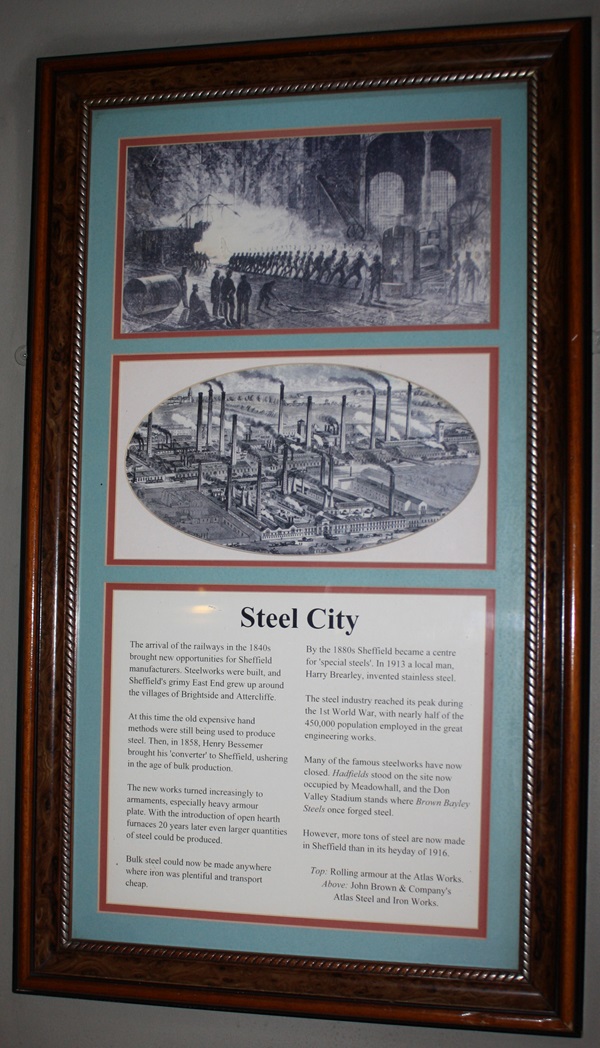
The text reads: The arrival of the railways in the 1840s brought new opportunities for Sheffield manufacturers. Steelworks were built, and Sheffield’s grimy East End grew up around the villages of Brightside and Attercliffe.
At this time the old expensive hand methods were still being used to produce steel. Then, in 1858, Henry Bessemer brought his ‘converter’ to Sheffield, ushering in the age of bulk production.
The new works turned increasingly to armaments, especially heavy armour plate. With the introduction of open hearth furnaces 20 years later even larger quantities of steel could be produced.
Bulk steel could now be made anywhere where iron was plentiful and transport cheap.
By the 1880s Sheffield became a centre for ‘special steels’. In 1913 a local man, Harry Brearley, invented stainless steel.
The steel industry reached its peak during the 1st World War, with nearly half of the 450,000 population employed in the great engineering works.
Many of the famous steelworks have now closed. Hadfields stood on the site now occupied by Meadowhall, and the Don Valley Stadium stands where Brown Bayley Steels once forged steel.
However, more tons of steel are now made in Sheffield than in its heyday of 1916.
Top: Rolling armour at the Atlas Works.
Above: John Brown & Company’s Atlas Steel and Iron Works.
Framed photograph, drawing and text about the Marsh family.

The text reads: Marsh Brothers & Co. Ltd. could date their involvement in Sheffield Steel back to at least 1614. The very first list of Sheffield cutlers in 1614 contained a George Marsh. It is almost unique, certainly in the Sheffield steel industry, for a firm to be able to trace its existence in the hands of one family for over 300 years. Family firms may have formed the backbone of the Industrial Revolution, but most of them started later, and were absorbed into other concerns much earlier.
Top: The Ponds Works in Shude Lane, c.1844. The workshop was fed by water from Ponds Dam, which took water from the River Sheaf.
Above: An advert for the American market, c.1848.
Left: A ‘state-of-the-art’ electric furnace in 1954.
A framed drawing and text about Thomas Boulsover.
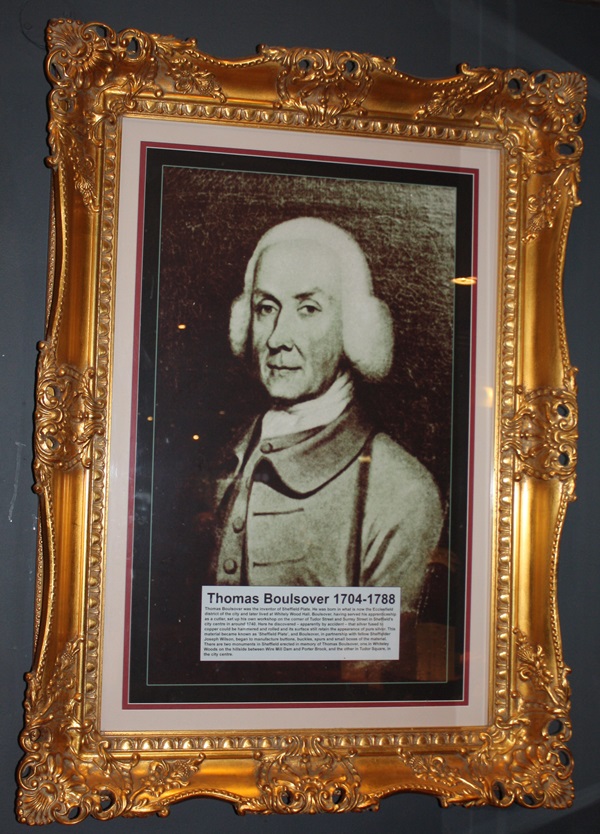
The text reads: Thomas Boulsover was the inventor of Sheffield Plate. He was born in what is now the Ecclesfield district of the city and later lived at Whiteley Wood Hall. Boulsover, having served his apprenticeship as a cutler, set up his own workshop on the corner of Tudor Street and Surrey Street in Sheffield’s city centre in around 1740. Here he discovered – apparently by accident – that silver fused to copper could be hammered and rolled and its surface still retain the appearance of pure silver. This material became known as ‘Sheffield Plate’, and Boulsover, in partnership with fellow Sheffielder Joseph Wilson, began to manufacture buttons, buckles, spurs and small boxes of the material. There are two monuments in Sheffield erected in memory of Thomas Boulsover, one in Whiteley Woods on the hillside between Wire Mill Dam and Porter Brook, and the other in Tudor Square, in the city centre.
Framed drawings, photographs and text about the benefactors of Sheffield.
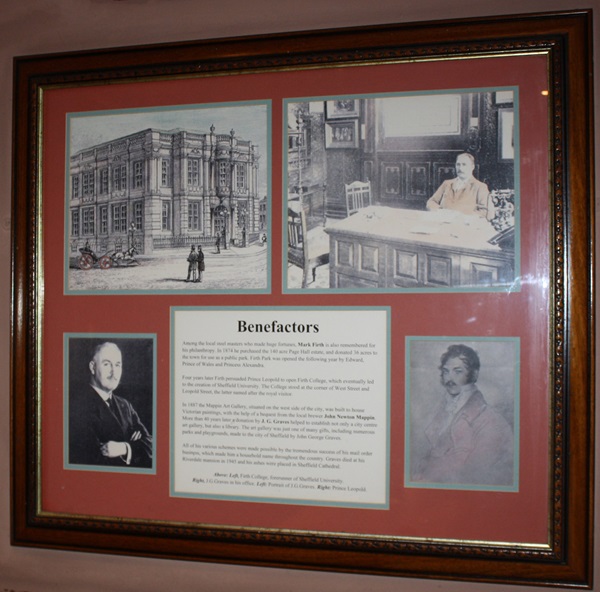
The text reads: Among the local steel masters who made huge fortune, Mark Firth is also remembered for his philanthropy. In 1874 he purchased the 140 acre Page Hall estate, and donated 36 acres to the town for use as a public park. Firth Park was opened the following year by Edward, Prince of Wales and Princess Alexandra.
Four years later Firth persuaded Prince Leopold to open Firth College, which eventually led to the creation of Sheffield University. The College stood at the corner of West Street and Leopold Street, the latter named after the royal visitor.
In 1887 the Mappin Art Gallery, situated on the west side of the city, was built to house Victorian paintings, with the help of a bequest from the local brewer John Newton Mappin. More than 40 years later a donation by J.G.Graves helped to establish not only a city centre art gallery, but also a library. The art gallery was just one of many gifts, including numerous parks and playgrounds, made to the city of Sheffield by John George Graves.
All of his various schemes were made possible by the tremendous success of his mail order business, which made him a household name throughout the country. Graves died at his Riverdale mansion in 1945 and his ashes were placed in Sheffield Cathedral.
Above: Left, Firth College, forerunner of Sheffield University.
Right, J.G.Graves in his office.
Left: Portrait of J.G.Graves.
Right: Prince Leopold.
Framed drawings of the Bessemer Plant.
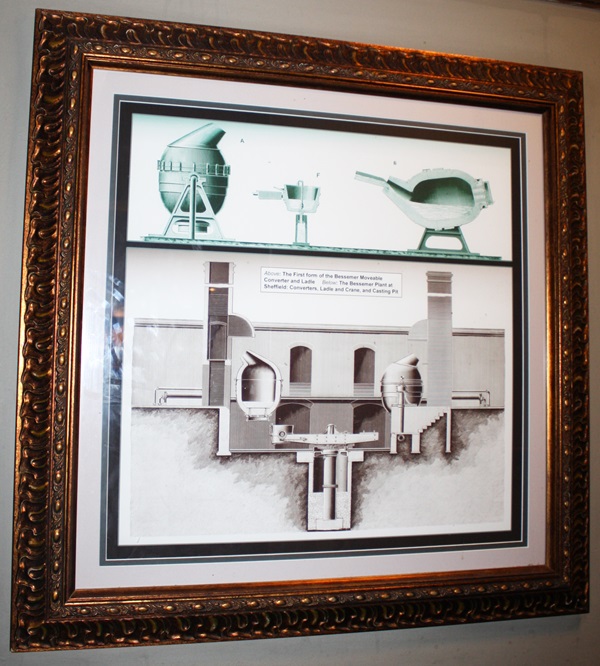
Above: The first form of the Bessemer Moveable Converter and Ladie.
Below: The Bessemer Plant at Sheffield: Converters, Ladie and Crane, and Casting Pit.
Framed photographs of High Street and Market Street c.1900.
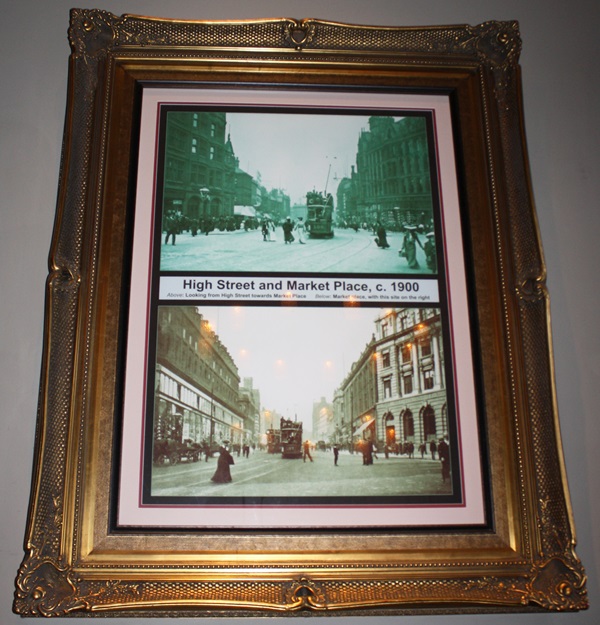
Above: Looking from High Street towards Market Place.
Below: Market place, with this site on the right.
Framed photographs of Norfolk Market Hall.
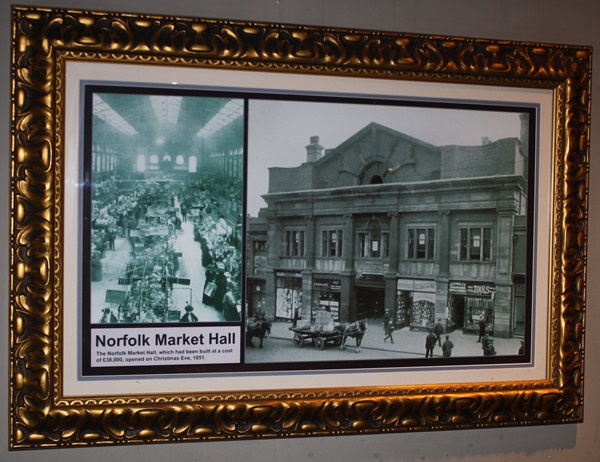
The Norfolk Market Hall, which had been built at a cost of £38,000, opened on Christmas Eve, 1851.
A framed photograph of the Ebenezer Elliott Monument, Market Place, c.1870.
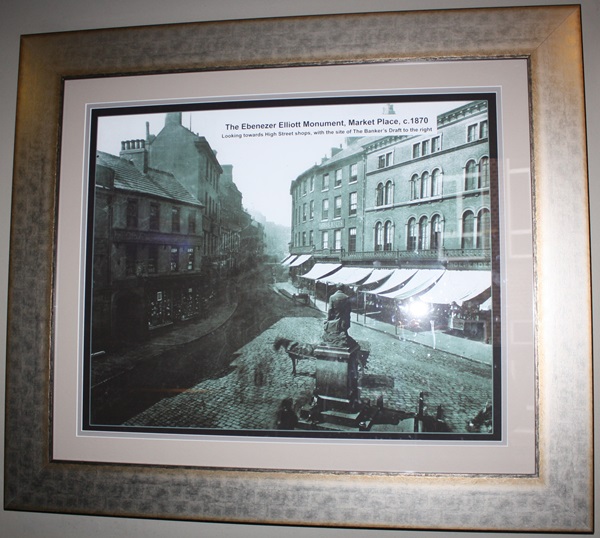
Looking towards High Street shops, with the site of The Banker’s Draft to the right.
A framed photograph of High Street from market Place, c.1965.
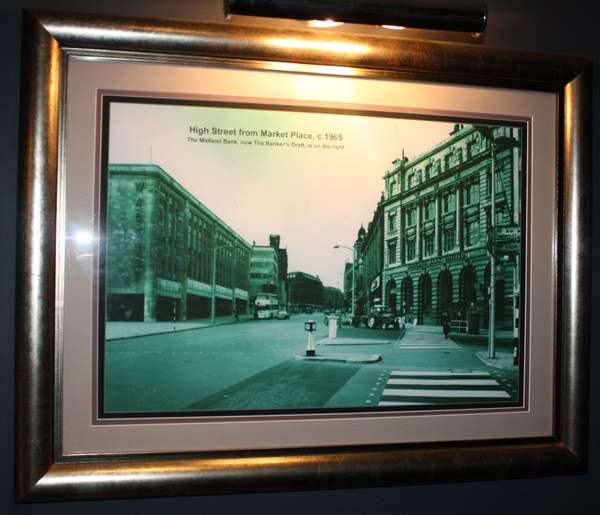
The Midland Bank, now the Banker’s Draft, is on the right.
A framed photograph of the Montgomery Tavern, 12 Hartshead, originally the office of the poet Montgomery.
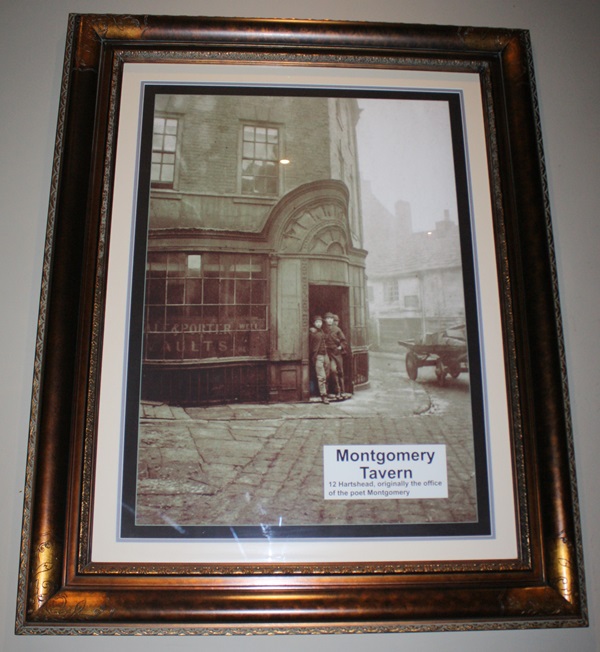
A framed photograph of Henry Fitzalan Howard, 15th Duke of Norfolk.
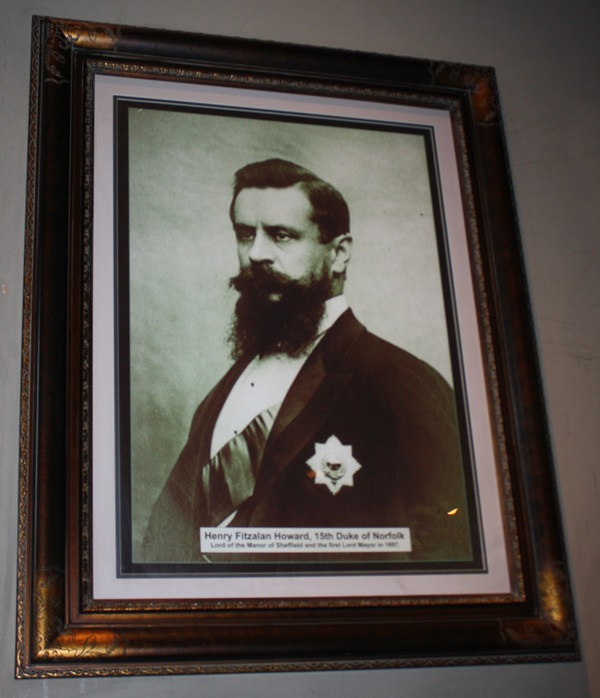
Lord of the Manor of Sheffield and the first Lord Mayor in 1897.
A framed photograph of Fitzalan Square.
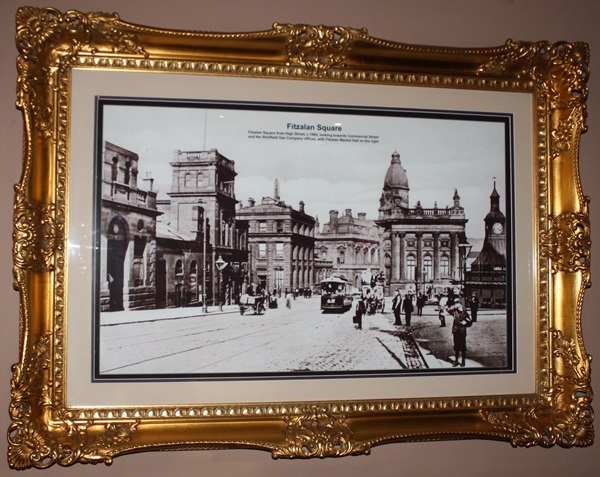
Fitzalan Sqaure from High Street, c.1905, looking towards Commercial Street and the Sheffield Gas Company offices, with Fitzalan Market Hall on the right.
A framed photograph of the first tram.
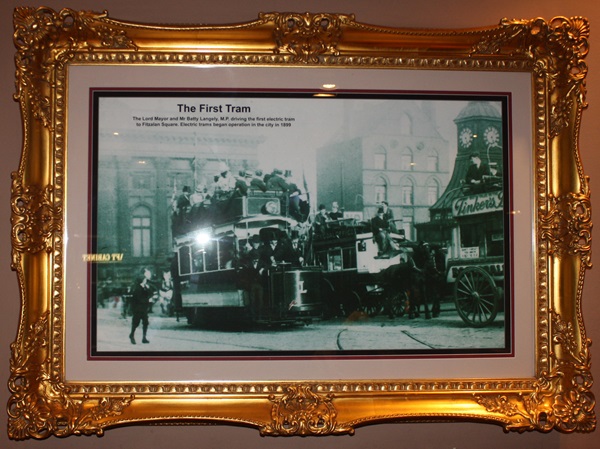
The Lord Mayor and Mr Batty Langley, M.P. driving the first electric tram to Fitzalan Square. Electric trams began operation in the city in 1899.
A piece of text about the Shrewsburys.
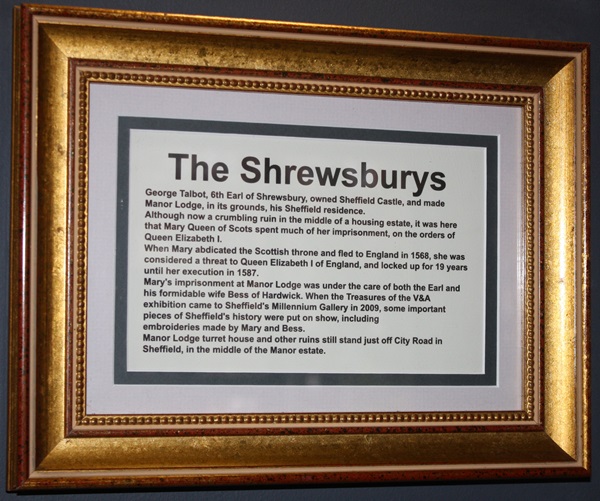
The text reads: George Talbot, 6th Earl of Shrewsbury, owned Sheffield Castle, and made Manor Lodge, in its grounds, his Sheffield residence.
Although now a crumbling ruin in the middle of a housing estate, it was here that Mary Queen of Scots spent much of her imprisonment, on the orders of Queen Elizabeth I.
When Mary abdicated the Scottish thrown and fled to England in 1568, she was considered a threat to Queen Elizabeth I of England, and locked up for 19 years until her execution in 1587.
Mary’s imprisonment at Manor Lodge was under the care of both the Earl and his formidable wife Bess of Hardwick. When the Treasure of the V&A exhibition came to Sheffield’s Millennium Gallery in 2009, some important pieces of Sheffield’s history were put on show, including embroideries made by Mary and Bess.
Manor Lodge turret house and other ruins still stand just off City Road in Sheffield, in the middle of the Manor estate.
Framed drawings and text about Mary Queen of Scots.
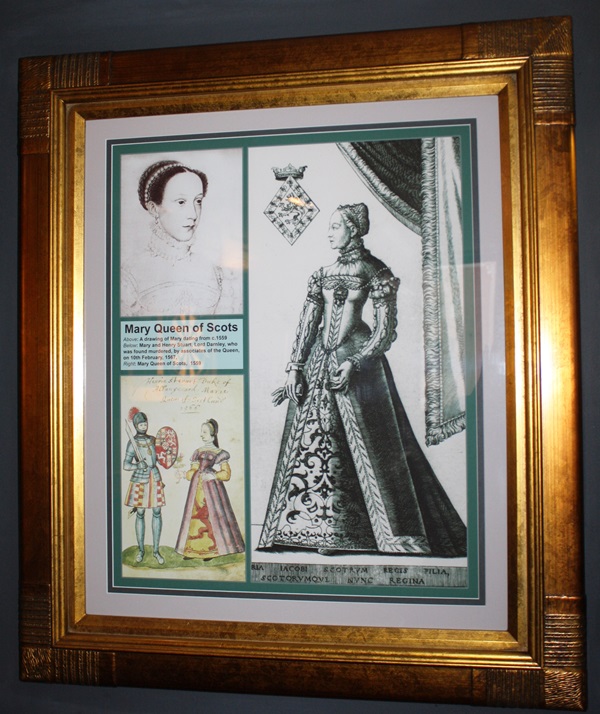
Above: A drawing of Mary dating from c.1559.
Below: Mary and Henry Stuart, Lord Darnley, who was found murdered, by associates of the Queen, on 10th February, 1567.
Right: Mary Queen of Scots, 1559.
External photograph of the building – front.
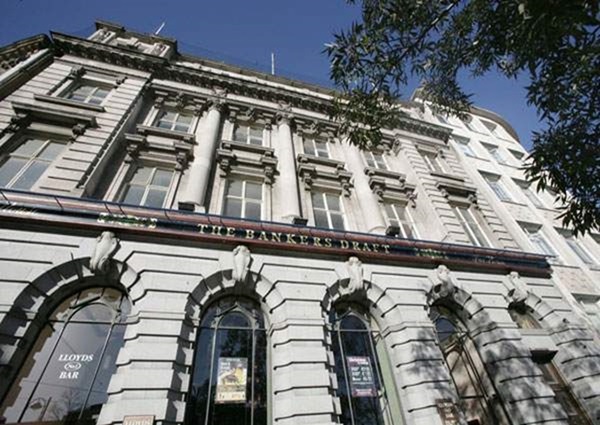
External photograph of the building – back.
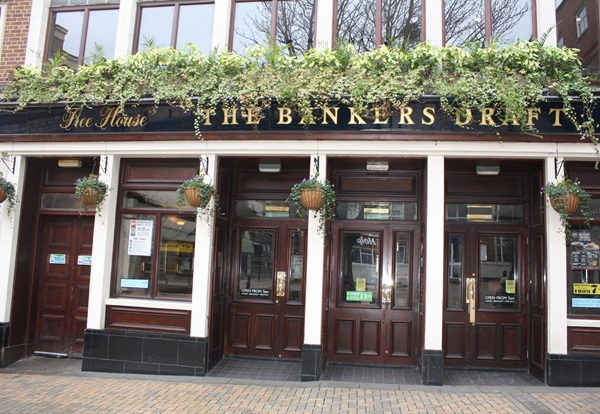
If you have information on the history of this pub, then we’d like you to share it with us. Please e-mail all information to: pubhistories@jdwetherspoon.co.uk